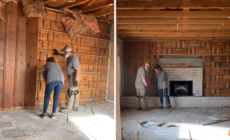-
What’s in the Trump Policy Bill? - about 1 min ago
-
Couple Renovate ‘Fixer-Upper’ House—Then They Realize What Was in the Walls - 18 mins ago
-
Hardcore birders and casual sparrow spotters: Science needs you - 39 mins ago
-
Steve Bannon’s Battle for the Soul of MAGA - 45 mins ago
-
Iran Suspect Preparing for Terror Attacks on Jews: Prosecutors - 53 mins ago
-
Owner Takes Dog To Say Goodbye to Little Sister, Reaction Breaks His Heart - about 1 hour ago
-
My First America - about 1 hour ago
-
Toddler Realizes She’s Black After Going to Daycare, Mom Has Perfect Response - 2 hours ago
-
Trump May Get His ‘Big Beautiful Bill,’ but the G.O.P. Will Pay a Price - 2 hours ago
-
Donald Trump Perfume Goes on Sale: Here’s What It Smells Like - 3 hours ago
Axial Seamount Volcano Set to Erupt off US Coast: Should People Be Worried?
Three hundred miles off the Oregon coast and 4,900 feet beneath the Pacific Ocean, Axial Seamount—one of the Pacific Northwest’s most active submarine volcanos—is showing signs of eruption.
Last active in 2015, scientists now believe the seafloor volcano could erupt before the end of 2025.
Why It Matters
Though perhaps not well known to the general public, Axial Seamount is considered a key window into Earth’s geology.
Axial is significant because it sits atop the Juan de Fuca Ridge, the region where the enormous Pacific and Juan de Fuca tectonic plates pull apart, forming the ocean crust.
“Over two-thirds of the Earth’s surface was formed by volcanic eruptions at these mid-ocean ridges,” according to Maya Tolstoy, marine geophysicist and Maggie Walker, dean of the University of Washington’s College of the Environment.

Nina Nelson/Getty Images
What To Know
The volcano’s summit features a caldera—formed by volcanic eruptions—and supports vibrant hydrothermal vent ecosystems populated by microbes, tube worms, crabs, fish, octopuses and more. Deborah Kelley, professor in the UW School of Oceanography said that while most of the sea floor is “relatively plain,” the volcano was an “oasis of life.”
These microbial communities rely on volcanic gases, not sunlight, for survival. However, eruptions can devastate them.
Kelly recalled: “In 2011, we saw one of the venting areas become completely covered in lava flows. It wiped everything out. But…three months later, there were animals and bacteria colonizing the area again. They’re surprisingly resilient ecosystems.”
Signs of eruption include increased seismic activity—200 to 300 quakes daily as of April—and ground inflation due to magma buildup.
Kelley explained that while the Axial Seamount has already inflated more than it did before its 2015 eruption, current earthquake activity remains relatively low. While quakes occasionally spike to 1,000 per day, if past patterns hold true, over 2,000 earthquakes would be expected daily for several months leading up to the next eruption.
Although an eruption is expected in the near future, experts say there is no danger to coastal communities. The eruption would be too deep and distant to generate tsunamis or trigger land-based earthquakes.
What People Are Saying
David Pyle, professor of Earth sciences with the University of Oxford in the U.K., told Newsweek: “It’s a long way beneath the sea surface—1500 meters—I’m not aware that there’s any visible disturbances that people have detected during past eruptions, and we’re a long way off shore.”
Pyle added: “The earthquakes are small, so they wouldn’t be felt at any significant distance from the volcanic system.”
What Happens Next
While the volcano is expected to erupt soon, the precise timings remain uncertain. It’s “a matter of chance,” Pyle said.
Source link





















